Networking and Addressing Concepts: Assignment 2, MIT4004
VerifiedAdded on 2022/08/30
|6
|1172
|23
Homework Assignment
AI Summary
This homework assignment solution addresses key concepts in networking. It begins by differentiating between classful and classless addressing in IPv4 and explains the inefficiencies of Class A and Class C address blocks. The solution then defines a mask in IPv4, explains network addresses, and describes subnetting and NAT, highlighting their roles in network management and address conservation. It also contrasts connection-oriented and connectionless services, defines fragmentation, and outlines strategies for transitioning from IPv4 to IPv6, including tunneling and dual-stack methods. The assignment further explores common address mapping protocols, ICMP, and autonomous systems. It concludes with discussions on the purpose and functions of RIP and OSPF, and contrasts distance vector and link-state routing protocols. The assignment is well-researched, referencing multiple sources to support the explanations.

MIT4004 0
MIT4004- Networking
MIT4004- Networking
Paraphrase This Document
Need a fresh take? Get an instant paraphrase of this document with our AI Paraphraser
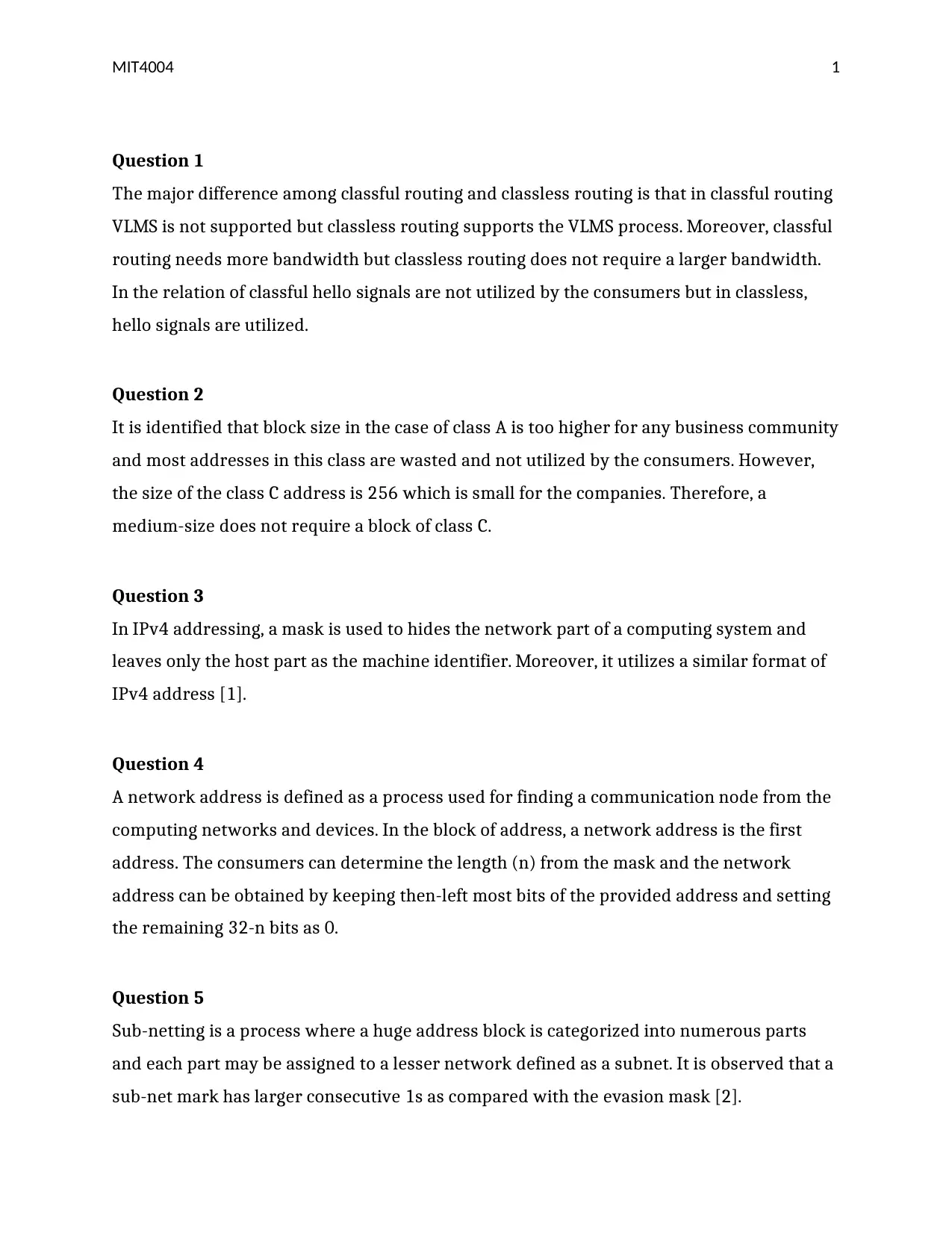
MIT4004 1
Question 1
The major difference among classful routing and classless routing is that in classful routing
VLMS is not supported but classless routing supports the VLMS process. Moreover, classful
routing needs more bandwidth but classless routing does not require a larger bandwidth.
In the relation of classful hello signals are not utilized by the consumers but in classless,
hello signals are utilized.
Question 2
It is identified that block size in the case of class A is too higher for any business community
and most addresses in this class are wasted and not utilized by the consumers. However,
the size of the class C address is 256 which is small for the companies. Therefore, a
medium-size does not require a block of class C.
Question 3
In IPv4 addressing, a mask is used to hides the network part of a computing system and
leaves only the host part as the machine identifier. Moreover, it utilizes a similar format of
IPv4 address [1].
Question 4
A network address is defined as a process used for finding a communication node from the
computing networks and devices. In the block of address, a network address is the first
address. The consumers can determine the length (n) from the mask and the network
address can be obtained by keeping then-left most bits of the provided address and setting
the remaining 32-n bits as 0.
Question 5
Sub-netting is a process where a huge address block is categorized into numerous parts
and each part may be assigned to a lesser network defined as a subnet. It is observed that a
sub-net mark has larger consecutive 1s as compared with the evasion mask [2].
Question 1
The major difference among classful routing and classless routing is that in classful routing
VLMS is not supported but classless routing supports the VLMS process. Moreover, classful
routing needs more bandwidth but classless routing does not require a larger bandwidth.
In the relation of classful hello signals are not utilized by the consumers but in classless,
hello signals are utilized.
Question 2
It is identified that block size in the case of class A is too higher for any business community
and most addresses in this class are wasted and not utilized by the consumers. However,
the size of the class C address is 256 which is small for the companies. Therefore, a
medium-size does not require a block of class C.
Question 3
In IPv4 addressing, a mask is used to hides the network part of a computing system and
leaves only the host part as the machine identifier. Moreover, it utilizes a similar format of
IPv4 address [1].
Question 4
A network address is defined as a process used for finding a communication node from the
computing networks and devices. In the block of address, a network address is the first
address. The consumers can determine the length (n) from the mask and the network
address can be obtained by keeping then-left most bits of the provided address and setting
the remaining 32-n bits as 0.
Question 5
Sub-netting is a process where a huge address block is categorized into numerous parts
and each part may be assigned to a lesser network defined as a subnet. It is observed that a
sub-net mark has larger consecutive 1s as compared with the evasion mask [2].
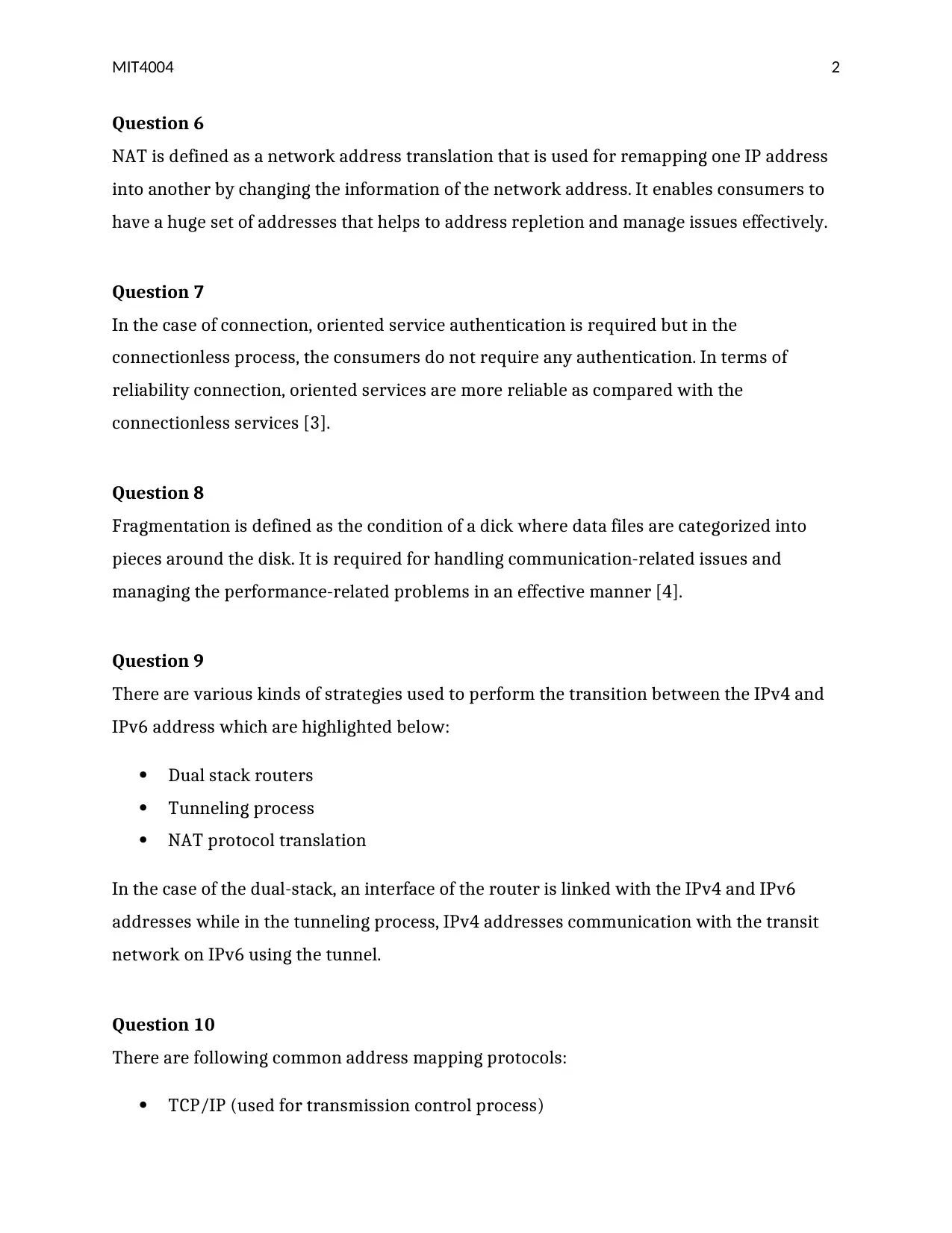
MIT4004 2
Question 6
NAT is defined as a network address translation that is used for remapping one IP address
into another by changing the information of the network address. It enables consumers to
have a huge set of addresses that helps to address repletion and manage issues effectively.
Question 7
In the case of connection, oriented service authentication is required but in the
connectionless process, the consumers do not require any authentication. In terms of
reliability connection, oriented services are more reliable as compared with the
connectionless services [3].
Question 8
Fragmentation is defined as the condition of a dick where data files are categorized into
pieces around the disk. It is required for handling communication-related issues and
managing the performance-related problems in an effective manner [4].
Question 9
There are various kinds of strategies used to perform the transition between the IPv4 and
IPv6 address which are highlighted below:
Dual stack routers
Tunneling process
NAT protocol translation
In the case of the dual-stack, an interface of the router is linked with the IPv4 and IPv6
addresses while in the tunneling process, IPv4 addresses communication with the transit
network on IPv6 using the tunnel.
Question 10
There are following common address mapping protocols:
TCP/IP (used for transmission control process)
Question 6
NAT is defined as a network address translation that is used for remapping one IP address
into another by changing the information of the network address. It enables consumers to
have a huge set of addresses that helps to address repletion and manage issues effectively.
Question 7
In the case of connection, oriented service authentication is required but in the
connectionless process, the consumers do not require any authentication. In terms of
reliability connection, oriented services are more reliable as compared with the
connectionless services [3].
Question 8
Fragmentation is defined as the condition of a dick where data files are categorized into
pieces around the disk. It is required for handling communication-related issues and
managing the performance-related problems in an effective manner [4].
Question 9
There are various kinds of strategies used to perform the transition between the IPv4 and
IPv6 address which are highlighted below:
Dual stack routers
Tunneling process
NAT protocol translation
In the case of the dual-stack, an interface of the router is linked with the IPv4 and IPv6
addresses while in the tunneling process, IPv4 addresses communication with the transit
network on IPv6 using the tunnel.
Question 10
There are following common address mapping protocols:
TCP/IP (used for transmission control process)
⊘ This is a preview!⊘
Do you want full access?
Subscribe today to unlock all pages.

Trusted by 1+ million students worldwide
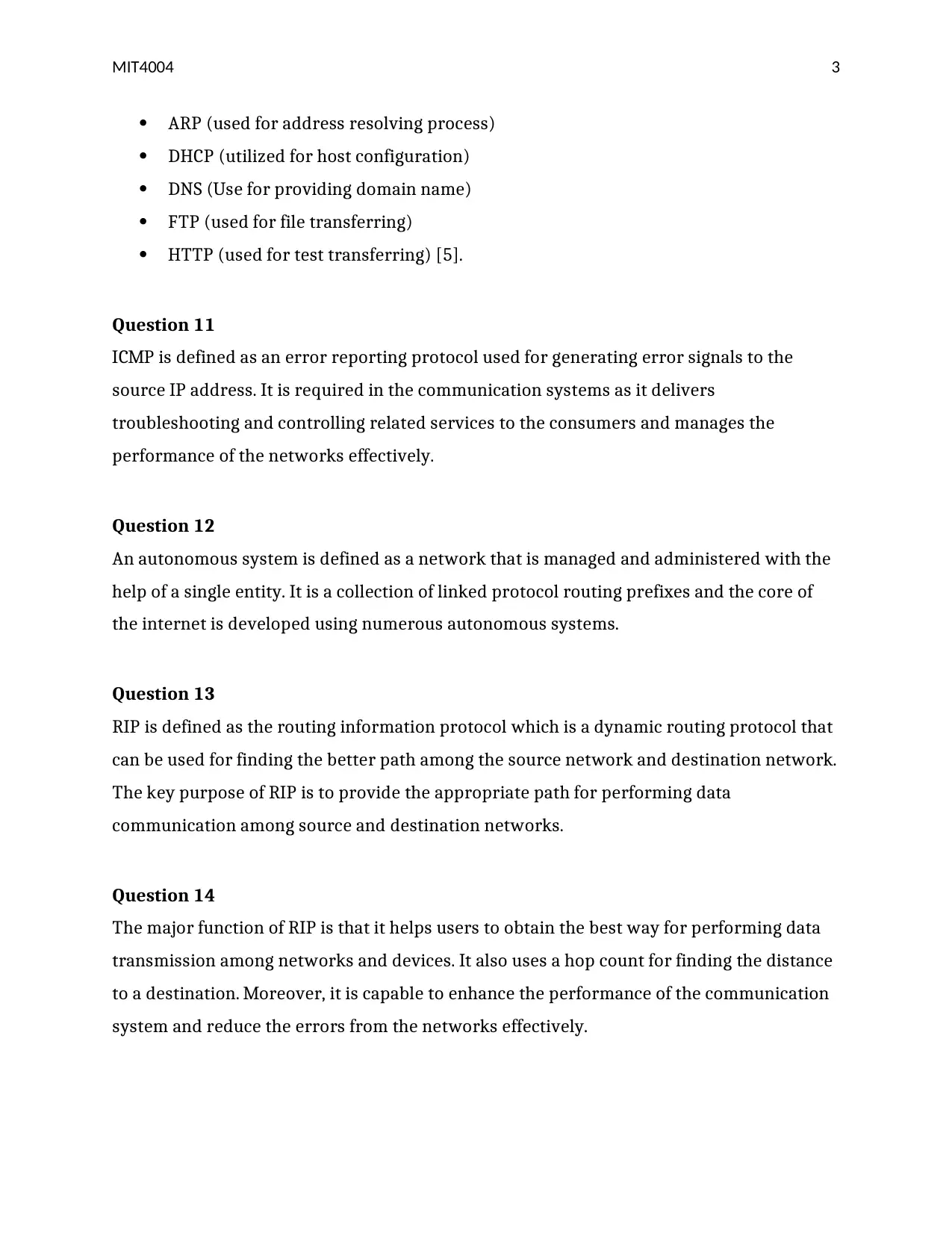
MIT4004 3
ARP (used for address resolving process)
DHCP (utilized for host configuration)
DNS (Use for providing domain name)
FTP (used for file transferring)
HTTP (used for test transferring) [5].
Question 11
ICMP is defined as an error reporting protocol used for generating error signals to the
source IP address. It is required in the communication systems as it delivers
troubleshooting and controlling related services to the consumers and manages the
performance of the networks effectively.
Question 12
An autonomous system is defined as a network that is managed and administered with the
help of a single entity. It is a collection of linked protocol routing prefixes and the core of
the internet is developed using numerous autonomous systems.
Question 13
RIP is defined as the routing information protocol which is a dynamic routing protocol that
can be used for finding the better path among the source network and destination network.
The key purpose of RIP is to provide the appropriate path for performing data
communication among source and destination networks.
Question 14
The major function of RIP is that it helps users to obtain the best way for performing data
transmission among networks and devices. It also uses a hop count for finding the distance
to a destination. Moreover, it is capable to enhance the performance of the communication
system and reduce the errors from the networks effectively.
ARP (used for address resolving process)
DHCP (utilized for host configuration)
DNS (Use for providing domain name)
FTP (used for file transferring)
HTTP (used for test transferring) [5].
Question 11
ICMP is defined as an error reporting protocol used for generating error signals to the
source IP address. It is required in the communication systems as it delivers
troubleshooting and controlling related services to the consumers and manages the
performance of the networks effectively.
Question 12
An autonomous system is defined as a network that is managed and administered with the
help of a single entity. It is a collection of linked protocol routing prefixes and the core of
the internet is developed using numerous autonomous systems.
Question 13
RIP is defined as the routing information protocol which is a dynamic routing protocol that
can be used for finding the better path among the source network and destination network.
The key purpose of RIP is to provide the appropriate path for performing data
communication among source and destination networks.
Question 14
The major function of RIP is that it helps users to obtain the best way for performing data
transmission among networks and devices. It also uses a hop count for finding the distance
to a destination. Moreover, it is capable to enhance the performance of the communication
system and reduce the errors from the networks effectively.
Paraphrase This Document
Need a fresh take? Get an instant paraphrase of this document with our AI Paraphraser
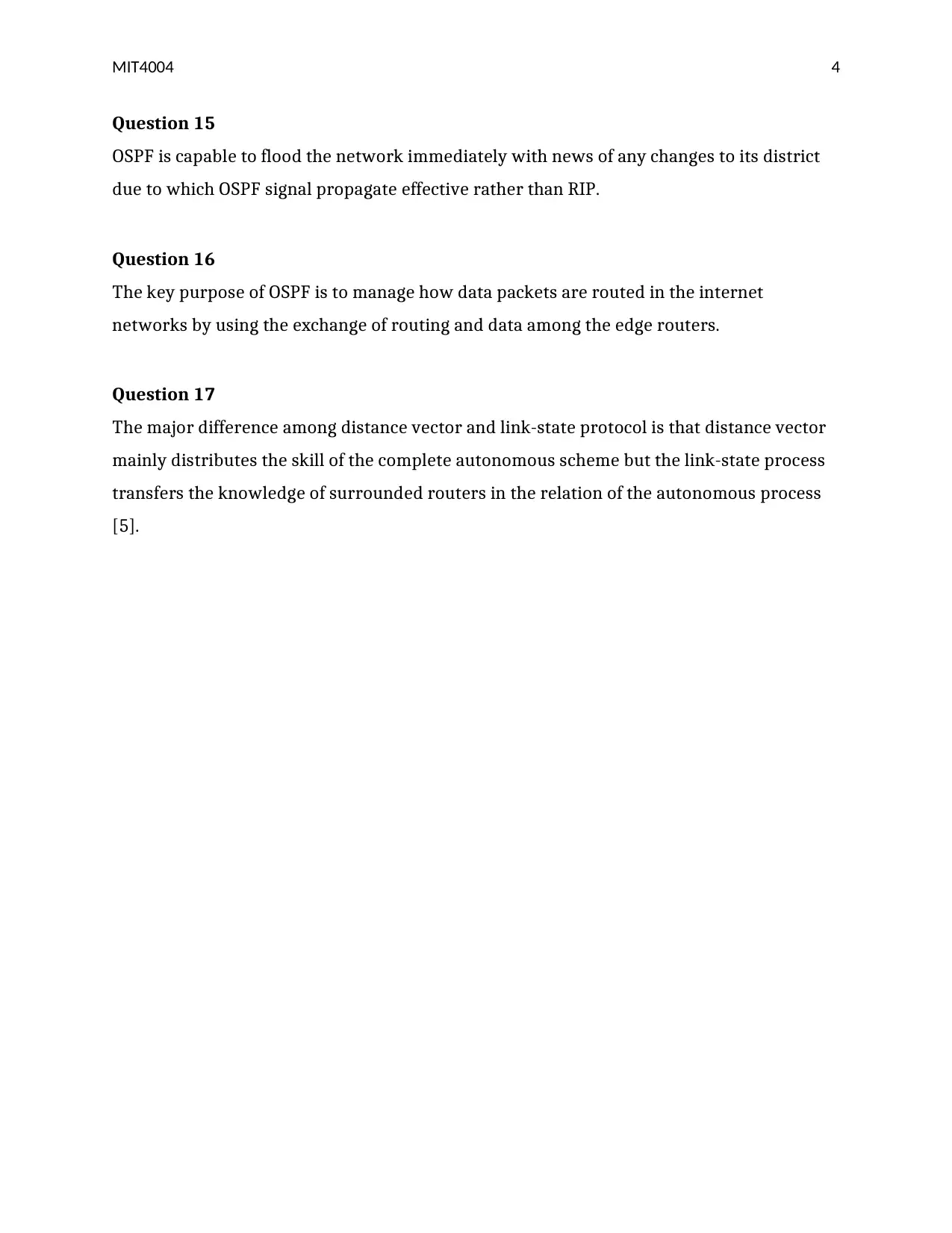
MIT4004 4
Question 15
OSPF is capable to flood the network immediately with news of any changes to its district
due to which OSPF signal propagate effective rather than RIP.
Question 16
The key purpose of OSPF is to manage how data packets are routed in the internet
networks by using the exchange of routing and data among the edge routers.
Question 17
The major difference among distance vector and link-state protocol is that distance vector
mainly distributes the skill of the complete autonomous scheme but the link-state process
transfers the knowledge of surrounded routers in the relation of the autonomous process
[5].
Question 15
OSPF is capable to flood the network immediately with news of any changes to its district
due to which OSPF signal propagate effective rather than RIP.
Question 16
The key purpose of OSPF is to manage how data packets are routed in the internet
networks by using the exchange of routing and data among the edge routers.
Question 17
The major difference among distance vector and link-state protocol is that distance vector
mainly distributes the skill of the complete autonomous scheme but the link-state process
transfers the knowledge of surrounded routers in the relation of the autonomous process
[5].
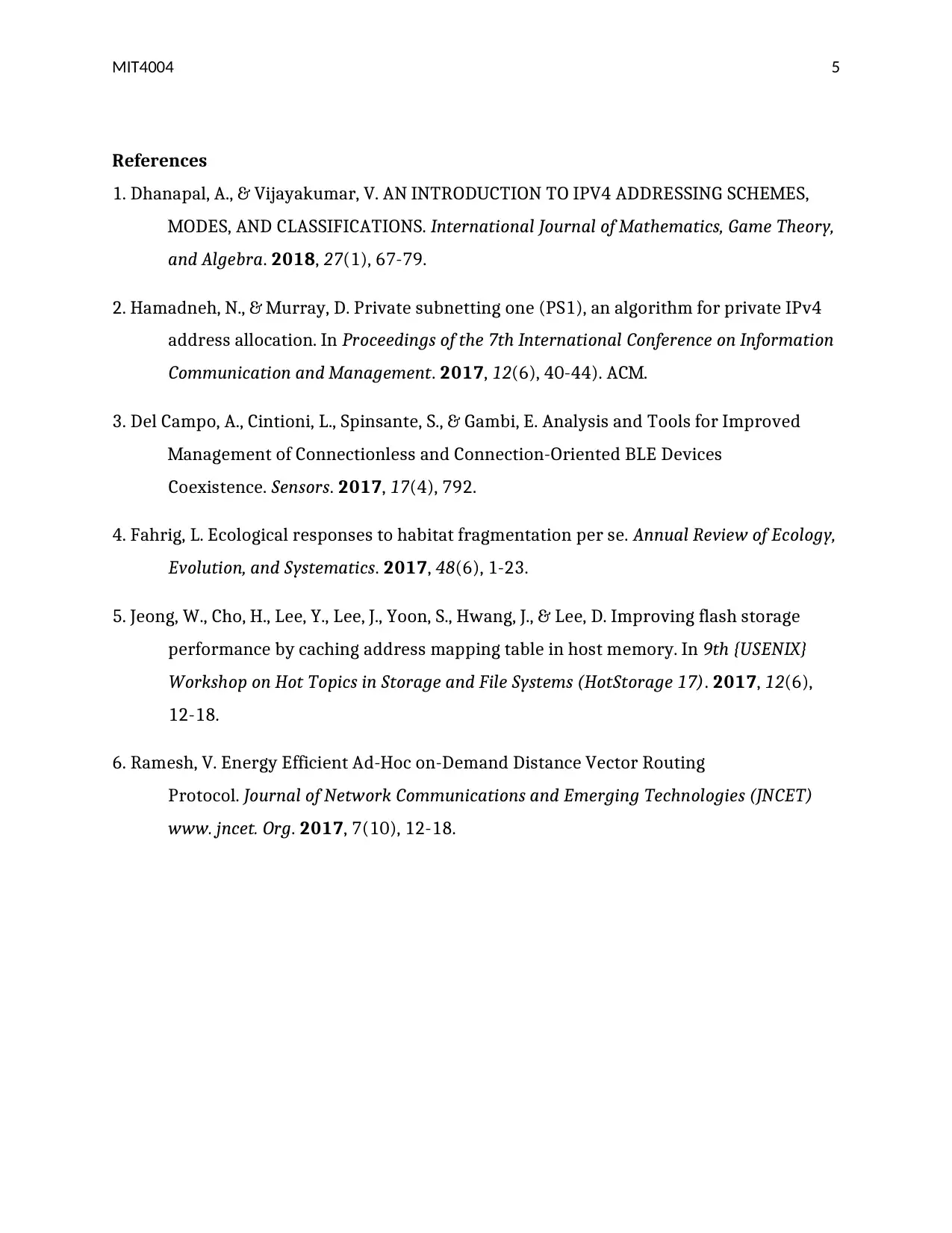
MIT4004 5
References
1. Dhanapal, A., & Vijayakumar, V. AN INTRODUCTION TO IPV4 ADDRESSING SCHEMES,
MODES, AND CLASSIFICATIONS. International Journal of Mathematics, Game Theory,
and Algebra. 2018, 27(1), 67-79.
2. Hamadneh, N., & Murray, D. Private subnetting one (PS1), an algorithm for private IPv4
address allocation. In Proceedings of the 7th International Conference on Information
Communication and Management. 2017, 12(6), 40-44). ACM.
3. Del Campo, A., Cintioni, L., Spinsante, S., & Gambi, E. Analysis and Tools for Improved
Management of Connectionless and Connection-Oriented BLE Devices
Coexistence. Sensors. 2017, 17(4), 792.
4. Fahrig, L. Ecological responses to habitat fragmentation per se. Annual Review of Ecology,
Evolution, and Systematics. 2017, 48(6), 1-23.
5. Jeong, W., Cho, H., Lee, Y., Lee, J., Yoon, S., Hwang, J., & Lee, D. Improving flash storage
performance by caching address mapping table in host memory. In 9th {USENIX}
Workshop on Hot Topics in Storage and File Systems (HotStorage 17). 2017, 12(6),
12-18.
6. Ramesh, V. Energy Efficient Ad-Hoc on-Demand Distance Vector Routing
Protocol. Journal of Network Communications and Emerging Technologies (JNCET)
www. jncet. Org. 2017, 7(10), 12-18.
References
1. Dhanapal, A., & Vijayakumar, V. AN INTRODUCTION TO IPV4 ADDRESSING SCHEMES,
MODES, AND CLASSIFICATIONS. International Journal of Mathematics, Game Theory,
and Algebra. 2018, 27(1), 67-79.
2. Hamadneh, N., & Murray, D. Private subnetting one (PS1), an algorithm for private IPv4
address allocation. In Proceedings of the 7th International Conference on Information
Communication and Management. 2017, 12(6), 40-44). ACM.
3. Del Campo, A., Cintioni, L., Spinsante, S., & Gambi, E. Analysis and Tools for Improved
Management of Connectionless and Connection-Oriented BLE Devices
Coexistence. Sensors. 2017, 17(4), 792.
4. Fahrig, L. Ecological responses to habitat fragmentation per se. Annual Review of Ecology,
Evolution, and Systematics. 2017, 48(6), 1-23.
5. Jeong, W., Cho, H., Lee, Y., Lee, J., Yoon, S., Hwang, J., & Lee, D. Improving flash storage
performance by caching address mapping table in host memory. In 9th {USENIX}
Workshop on Hot Topics in Storage and File Systems (HotStorage 17). 2017, 12(6),
12-18.
6. Ramesh, V. Energy Efficient Ad-Hoc on-Demand Distance Vector Routing
Protocol. Journal of Network Communications and Emerging Technologies (JNCET)
www. jncet. Org. 2017, 7(10), 12-18.
⊘ This is a preview!⊘
Do you want full access?
Subscribe today to unlock all pages.

Trusted by 1+ million students worldwide
1 out of 6
Related Documents
Your All-in-One AI-Powered Toolkit for Academic Success.
+13062052269
info@desklib.com
Available 24*7 on WhatsApp / Email
![[object Object]](/_next/static/media/star-bottom.7253800d.svg)
Unlock your academic potential
Copyright © 2020–2025 A2Z Services. All Rights Reserved. Developed and managed by ZUCOL.





